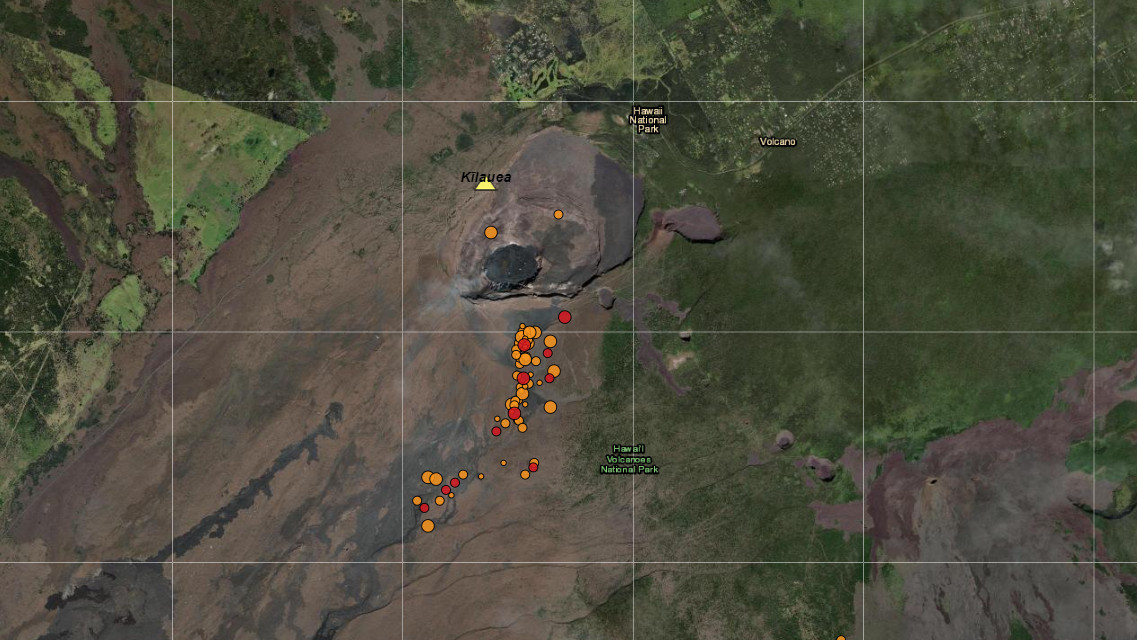(BIVN) – Kilauea volcano on the Island of Hawaiʻi is not erupting. After a few weeks of relative quiet, increased seismicity to the south of Kīlauea’s summit started on Friday afternoon and continues into the evening.
The USGS Hawaiian Volcano Observatory issued a special Kīlauea information statement detailing the latest episode of elevated unrest, reporting that there have been “over 80 locatable earthquakes in this region in the past 6 hours and many smaller earthquakes.”
The USGS alert level for Kīlauea remains at ADVISORY and as of early Friday evening there were no new closures reported in Hawaiʻi Volcanoes National Park due to the elevated unrest.
From the USGS HVO:
Kīlauea volcano is not erupting. Elevated unrest and increased seismicity to the south of Kīlauea’s summit started today, December 29, around 1:10 p.m. HST and is continuing. The seismicity followed a sharp increase in the rate of inflation on the Sand Hill tiltmeter that began at 12:30 p.m. HST and is continuing. The increased seismicity began just to the south of Halemaʻumaʻu and has progressively included a larger region to the south of the caldera about 2–4 km (1–2.5 mi) south of Halema‘uma‘u crater. The seismicity is occurring at depths of 1–3 km (0.5–2 mi) with magnitudes ranging from a maximum of 2.5 to less than 1. There have been over 80 locatable earthquakes in this region in the past 6 hours and many smaller earthquakes.
The summit of Kīlauea remains at a high level of inflation and eruptive activity at the summit is possible with little or no warning. No unusual activity has been noted along Kīlauea’s East Rift Zone or Southwest Rift Zone. The current Volcano Alert Level remains at ADVISORY. The current Aviation Color Code remains at YELLOW.
RECENT OBSERVATIONS
The most recent eruption at Kīlauea summit ended on September 16, 2023, but was followed by a significant intrusion to the southwest of Kīlauea caldera. Seismicity has waxed and waned since then alternating between the southwest area, the south end of the caldera, and the upper East Rift Zone. Most recent seismicity has alternated between the summit caldera and the upper East Rift Zone.
A map of the October intrusive activity is available here.
INTERPRETATION AND CONTEXT
Earthquake swarms like this can precede eruptions, but there is no lateral or upward migration of earthquakes that would suggest magma is moving toward the surface at this time. There are currently no signs of an imminent eruption at Kīlauea, but the volcano’s summit region remains unsettled, with a high level of inflation and continued seismic activity.
HVO continues to closely monitor Kīlauea volcano, watching for any signs of accelerated rates of earthquakes or ground deformation, or signs of shallowing earthquake locations, which usually precede a new outbreak of lava or propagating dike. We are also closely monitoring gas emissions and webcam imagery.


by Big Island Video News7:57 pm
on at
STORY SUMMARY
HAWAIʻI VOLCANOES NATIONAL PARK - A new episode of elevated unrest started south of Kīlauea's summit on Friday afternoon.